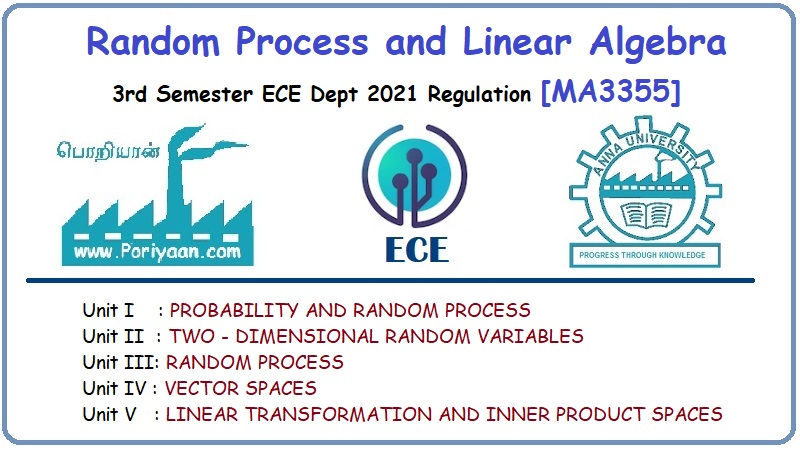Random Process and Linear Algebra: Unit I: Probability and Random Variables,,
Problems on Mutually Exclusive
Important Problems on P(AUB) = P(A) + P(B) (or) P(A + B) = P(A) + P(B)
Type 1. (b) Mutually Exclusive
P(AUB) = P(A) + P(B) (or) P(A + B) = P(A) + P(B)
Example 1.1.12
One card is drawn from a pack of 52
cards. What is the probability that it is either a king or a queen.
Solution :
A = {an event that the card drawn is
king}
P(A) = n(A)/n(S) = 4/52 = 1/13
B = {an event that the card drawn is
queen}
P(B) = n(B)/n(S) = 4/52 = 1/13
AUB = {an event that the card to be either a king or a queen}
P(AUB) = P(A) + P(B) ['.' A and B are
mutually exclusive events]
= (1/13) + (1/13) = 2/13
Example 1.1.13
From a group of 5 first year, 4 second
year and 4 third year students, 3 students are selected at random. Find the
probability that they are first year or third year students.
Solution:
Total number of students in the group =
13
Three students are selected at random
n(S) = 13C3= 13.12.11 / 1.2.3 = 286
A -> The three students are from
first year
i.e., n(A) = 5C3 = 5.4.3 /
1.2.3 = 10
P(A) = n(A)/n(S) = 10/286
B -> The three students are from
third year
n(B) = 4C3 = 4
p(B) = n(B)/n(S) = 4/286
Here A and B are disjoint events since
both cannot occur together.
P(AUB) = P(A) + P(B)
(10/286) + (4/286) = 14/286 = 7/143
Example 1.1.14
A bag contains 30 balls numbered from 1
to 30. One ball is drawn at random. Find the probability that the number of the
ball drawn will be a multiple of (a) 5 or 7 and (b) 3 or 7.
Solution:
Given: n(S) = 30
Let A = The probability of the number
being multiple of 5.
p(A) = p(5, 10, 15, 20, 25, 30) = 6/30
Let B = The probability of the number
being multiple of 7.
p(B) = P(7, 14, 21, 28) = 4/30
Let C = The probability of the number
being multiple of 3.
p(C) = p(3, 6, 9, 12, 15, 18, 21, 24,
27, 30) = 10/30
(a) The events A and B are mutually
exclusive the probability of the number being a multiple of 5 or 7 will be
= (6/30) + (4/30) = 10/30
(b) The events C and B are not mutually
exclusive.
Here p(C∩B) = p[21] = 1/30
.'. p(CUB) = p(C) + p(B) - p(C∩B)
= (10/30) + (4/30) - (1/30) = 13/30
Example 1.1.15
What is the probability of picking a
card that was red or black?
Solution:
Let A -> The event of picking a red card.
B -> The event of picking a black
card. 26
p(A) = 26/52; p(B) = 26/52
P(AUB) = p(A) + p(B) = (26/52) + (26/52)
= 1
Random Process and Linear Algebra: Unit I: Probability and Random Variables,, : Tag: : - Problems on Mutually Exclusive
Related Topics
Related Subjects
Random Process and Linear Algebra
MA3355 - M3 - 3rd Semester - ECE Dept - 2021 Regulation | 3rd Semester ECE Dept 2021 Regulation
